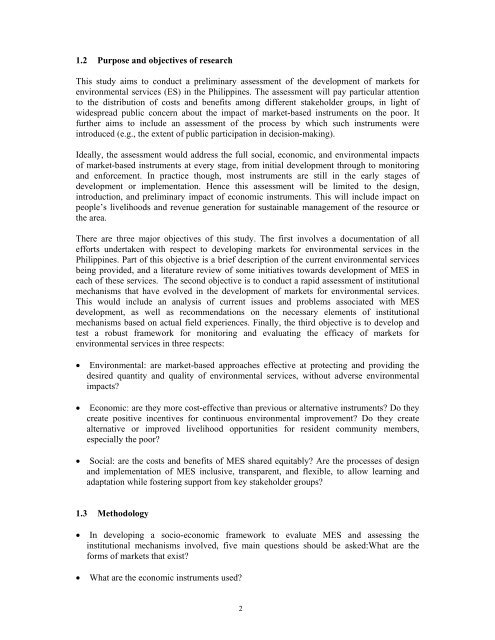Developing pro-poor markets for environmental services in the ...
Developing pro-poor markets for environmental services in the ...
Developing pro-poor markets for environmental services in the ...
You also want an ePaper? Increase the reach of your titles
YUMPU automatically turns print PDFs into web optimized ePapers that Google loves.
1.2 Purpose and objectives of research<br />
This study aims to conduct a prelim<strong>in</strong>ary assessment of <strong>the</strong> development of <strong>markets</strong> <strong>for</strong><br />
<strong>environmental</strong> <strong>services</strong> (ES) <strong>in</strong> <strong>the</strong> Philipp<strong>in</strong>es. The assessment will pay particular attention<br />
to <strong>the</strong> distribution of costs and benefits among different stakeholder groups, <strong>in</strong> light of<br />
widespread public concern about <strong>the</strong> impact of market-based <strong>in</strong>struments on <strong>the</strong> <strong>poor</strong>. It<br />
fur<strong>the</strong>r aims to <strong>in</strong>clude an assessment of <strong>the</strong> <strong>pro</strong>cess by which such <strong>in</strong>struments were<br />
<strong>in</strong>troduced (e.g., <strong>the</strong> extent of public participation <strong>in</strong> decision-mak<strong>in</strong>g).<br />
Ideally, <strong>the</strong> assessment would address <strong>the</strong> full social, economic, and <strong>environmental</strong> impacts<br />
of market-based <strong>in</strong>struments at every stage, from <strong>in</strong>itial development through to monitor<strong>in</strong>g<br />
and en<strong>for</strong>cement. In practice though, most <strong>in</strong>struments are still <strong>in</strong> <strong>the</strong> early stages of<br />
development or implementation. Hence this assessment will be limited to <strong>the</strong> design,<br />
<strong>in</strong>troduction, and prelim<strong>in</strong>ary impact of economic <strong>in</strong>struments. This will <strong>in</strong>clude impact on<br />
people’s livelihoods and revenue generation <strong>for</strong> susta<strong>in</strong>able management of <strong>the</strong> resource or<br />
<strong>the</strong> area.<br />
There are three major objectives of this study. The first <strong>in</strong>volves a documentation of all<br />
ef<strong>for</strong>ts undertaken with respect to develop<strong>in</strong>g <strong>markets</strong> <strong>for</strong> <strong>environmental</strong> <strong>services</strong> <strong>in</strong> <strong>the</strong><br />
Philipp<strong>in</strong>es. Part of this objective is a brief description of <strong>the</strong> current <strong>environmental</strong> <strong>services</strong><br />
be<strong>in</strong>g <strong>pro</strong>vided, and a literature review of some <strong>in</strong>itiatives towards development of MES <strong>in</strong><br />
each of <strong>the</strong>se <strong>services</strong>. The second objective is to conduct a rapid assessment of <strong>in</strong>stitutional<br />
mechanisms that have evolved <strong>in</strong> <strong>the</strong> development of <strong>markets</strong> <strong>for</strong> <strong>environmental</strong> <strong>services</strong>.<br />
This would <strong>in</strong>clude an analysis of current issues and <strong>pro</strong>blems associated with MES<br />
development, as well as recommendations on <strong>the</strong> necessary elements of <strong>in</strong>stitutional<br />
mechanisms based on actual field experiences. F<strong>in</strong>ally, <strong>the</strong> third objective is to develop and<br />
test a robust framework <strong>for</strong> monitor<strong>in</strong>g and evaluat<strong>in</strong>g <strong>the</strong> efficacy of <strong>markets</strong> <strong>for</strong><br />
<strong>environmental</strong> <strong>services</strong> <strong>in</strong> three respects:<br />
• Environmental: are market-based ap<strong>pro</strong>aches effective at <strong>pro</strong>tect<strong>in</strong>g and <strong>pro</strong>vid<strong>in</strong>g <strong>the</strong><br />
desired quantity and quality of <strong>environmental</strong> <strong>services</strong>, without adverse <strong>environmental</strong><br />
impacts?<br />
• Economic: are <strong>the</strong>y more cost-effective than previous or alternative <strong>in</strong>struments? Do <strong>the</strong>y<br />
create positive <strong>in</strong>centives <strong>for</strong> cont<strong>in</strong>uous <strong>environmental</strong> im<strong>pro</strong>vement? Do <strong>the</strong>y create<br />
alternative or im<strong>pro</strong>ved livelihood opportunities <strong>for</strong> resident community members,<br />
especially <strong>the</strong> <strong>poor</strong>?<br />
• Social: are <strong>the</strong> costs and benefits of MES shared equitably? Are <strong>the</strong> <strong>pro</strong>cesses of design<br />
and implementation of MES <strong>in</strong>clusive, transparent, and flexible, to allow learn<strong>in</strong>g and<br />
adaptation while foster<strong>in</strong>g support from key stakeholder groups?<br />
1.3 Methodology<br />
• In develop<strong>in</strong>g a socio-economic framework to evaluate MES and assess<strong>in</strong>g <strong>the</strong><br />
<strong>in</strong>stitutional mechanisms <strong>in</strong>volved, five ma<strong>in</strong> questions should be asked:What are <strong>the</strong><br />
<strong>for</strong>ms of <strong>markets</strong> that exist?<br />
• What are <strong>the</strong> economic <strong>in</strong>struments used?<br />
2
















